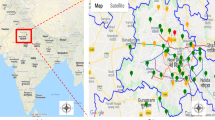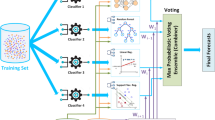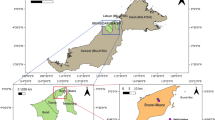Abstract
Despite the apparent improvement in air quality in recent years through a series of effective measures, the concentration of PM2.5 and O3 in Chengdu city remains high. And both the two pollutants can cause serious damage to human health and property; consequently, it is imperative to accurately forecast hourly concentration of PM2.5 and O3 in advance. In this study, an air quality forecasting method based on random forest (RF) method and improved ant colony algorithm coupled with back-propagation neural network (IACA-BPNN) are proposed. RF method was used to screen out highly correlated input variables, and the improved ant colony algorithm (IACA) was adopted to combine with BPNN to improve the convergence performance. Two datasets based on two different kinds of monitoring stations along with meteorological data were applied to verify the performance of this proposed model and compared with another five plain models. The results showed that the RF-IACA-BPNN model has the minimum statistical error of the mean absolute error, root mean square error, and mean absolute percentage error, and the values of R2 consistently outperform other models. Thus, it is concluded that the proposed model is suitable for air quality prediction. It was also detected that the performance of the models for the forecasting of the hourly concentrations of PM2.5 were more acceptable at suburban station than downtown station, while the case is just the opposite for O3, on account of the low variability dataset at suburban station.








Similar content being viewed by others
References
Abdul-Wahab SA, Al-Alawi SM (2002) Assessment and prediction of tropospheric ozone concentration levels using artificial neural networks. Environ Modell Software 17(3):219–228. https://doi.org/10.1016/S1364-8152(01)00077-9
Ahmad M, Cheng S, Yu Q et al (2019) Chemical and source characterization of PM 2.5 in summertime in severely polluted Lahore, Pakistan. Atmospheric Res 234:104715. https://doi.org/10.1016/j.atmosres.2019.104715
Alimissis A, Philippopoulos K, Tzanis CG et al (2018) Spatial estimation of urban air pollution with the use of artificial neural network models. Atmospheric Environ 191:205–213. https://doi.org/10.1016/j.atmosenv.2018.07.058
Almeida J, Schobesberger S, Kürten A et al (2013) Molecular understanding of sulphuric acid–amine particle nucleation in the atmosphere. Nature 502:359–363. https://doi.org/10.1038/nature12663
Arden Pope C III (2002) Lung cancer, cardiopulmonary mortality, and long-term exposure to fine particulate air pollution. Jama 287(9):1132–1141. https://doi.org/10.1001/jama.287.9.1132
Aslanargun A, Mammadov M, Yazici B et al (2007) Comparison of ARIMA, neural networks and hybrid models in time series: tourist arrival forecasting. J Stat Comput Simul 77(1/2):29–53. https://doi.org/10.1080/10629360600564874
Biancofiore F, Busilacchio M, Verdecchia M et al (2017) Recursive neural network model for analysis and forecast of PM10 and PM2.5. Atmospheric. Pollution Res 8(4):652–659. https://doi.org/10.1016/j.apr.2016.12.014
Cheng B, Ma Y, Feng F et al (2021) Influence of weather and air pollution on concentration change of PM2.5 using a generalized additive model and gradient boosting machine. Atmospheric Environ 255(D12):118437. https://doi.org/10.1016/j.atmosenv.2021.118437
Corani G, Scanagatta M (2016) Air pollution prediction via multi-label classification. Environ Modell Software 80:259–264. https://doi.org/10.1016/j.envsoft.2016.02.030
Cobourn WG (2010) An enhanced PM2.5 air quality forecast model based on nonlinear regression and back-trajectory concentrations. Atmospheric Environ 44(25):3015–3023. https://doi.org/10.1016/j.atmosenv.2010.05.009
Dawson JP, Adams PJ, Pandis SN (2007) Sensitivity of PM2.5 to climate in the Eastern US: a modeling case study. Atmospheric Chem Phys 7:4295–4309. https://doi.org/10.5194/acp-7-4295-2007
Dorigo M, Stützle T (2003) The ant colony optimization metaheuristic: algorithms, applications, and advances. New Ideas Optimiz 57:250–285. https://doi.org/10.1007/0-306-48056-5_9
Fan YV, Perry S, Klemeš JJ, Lee CT (2018) A review on air emissions assessment: transportation. J Cleaner Product 194:673–684. https://doi.org/10.1016/j.jclepro.2018.05.151
Feng X, Li Q, Zhu Y, Hou J, ** L, Wang J (2015) Artificial neural networks forecasting of PM2.5 pollution using air mass trajectory based geographic model and wavelet transformation. Atmospheric Environ 107:118–128. https://doi.org/10.1016/j.atmosenv.2015.02.030
Feng Y, Zhang W, Sun D, Zhang L (2011) Ozone concentration forecast method based on genetic algorithm optimized back propagation neural networks and support vector machine data classification. Atmospheric Environ 45(11):1979–1985. https://doi.org/10.1016/j.atmosenv.2011.01.022
Gao M, Yin L, Ning J (2018) Artificial neural network model for ozone concentration estimation and Monte Carlo analysis. Atmospheric Environ 184:129–139. https://doi.org/10.1016/j.atmosenv.2018.03.027
Guo ZH, Jie W, Lu HY et al (2011) A case study on a hybrid wind speed forecasting method using BP neural network. Knowledge-Based Syst 24(7):1048–1056. https://doi.org/10.1016/j.scitotenv.2003.11.009
Hao Y, Tian C, Wu C (2019) Modelling of carbon price in two real carbon trading markets. J Cleaner Product 244:118556. https://doi.org/10.1016/j.jclepro.2019.118556
Heo JS, Kim DS (2004) A new method of ozone forecasting using fuzzy expert and neural network systems. Sci Total Environ 325(1-3):221–237. https://doi.org/10.1016/j.scitotenv.2003.11.009
Hoshyaripour G, Brasseur G, Andrade MF et al (2016) Prediction of ground-level ozone concentration in São Paulo, Brazil: Deterministic versus statistic models. Atmospheric Environ 145:365–375. https://doi.org/10.1016/j.atmosenv.2016.09.061
Hu Y, Li J, Hong M et al (2019) Short term electric load forecasting model and its verification for process industrial enterprises based on hybrid GA-PSO-BPNN algorithm—A case study of papermaking process. Energy 170:1215–1227. https://doi.org/10.1016/j.energy.2018.12.208
Huang Y, **ang Y, Zhao R, Cheng Z (2020) Air quality prediction using improved PSO-BP neural network. IEEE Access 8:99346–99353. https://doi.org/10.1109/ACCESS.2020.2998145
Jacob DJ (2000) Heterogeneous chemistry and tropospheric ozone. Atmospheric. Environ 34(12):2131–2159. https://doi.org/10.1016/S1352-2310(99)00462-8
Jacob DJ, Winner DA (2009) Effect of climate change on air quality. Atmospheric Environ 43:51–63. https://doi.org/10.1016/j.atmosenv.2008.09.051
Jakobs HJ, Tilmes S, Heidegger A et al (2002) Short-term ozone forecasting with a network model system during summer 1999. J Atmospheric Chem 42:23–40. https://doi.org/10.1023/A:1015767207688
** C, ** SW, Qin LN (2012) Attribute selection method based on a hybrid BPNN and PSO algorithms. Appl Soft Comput 12(8):2147–2155. https://doi.org/10.1016/j.asoc.2012.03.015
Konovalov IB, Beekmann M, Meleux F et al (2009) Combining deterministic and statistical approaches for PM10 forecasting in Europe. Atmospheric Environ 43(40):6425–6434. https://doi.org/10.1016/j.atmosenv.2009.06.039
Krishan M, Jha S, Das J et al (2019) Air quality modelling using long short-term memory (LSTM) over NCT-Delhi, India. Air Quality, Atmosphere & Health 12(8):899–908. https://doi.org/10.1007/s11869-019-00696-7
Lauret P, Heymes F, Aprin L, Johannet A (2016) Atmospheric dispersion modeling using artificial neural network based cellular automata. Environ Modell Software 85:56–69. https://doi.org/10.1007/s11869-019-00696-7
Li H, Wang J, Lu H, Guo Z (2018) Research and application of a combined model based on variable weight for short term wind speed forecasting. Renewable Energy 116:669–684. https://doi.org/10.1016/j.renene.2017.09.089
Liu F, Gong H, Cai L, Xu K (2019) Prediction of ammunition storage reliability based on improved ant colony algorithm and BP neural network. Complexity 2019:1–13. https://doi.org/10.1155/2019/5039097
Liu H, Mi XW, Li YF (2018) Wind speed forecasting method based on deep learning strategy using empirical wavelet transform, long short term memory neural network and Elman neural network. Energy Convers Manag 156:498–514. https://doi.org/10.1016/j.enconman.2017.11.053
Liu S, Xu L, Li D (2016) Multi-scale prediction of water temperature using empirical mode decomposition with back-propagation neural networks. Comput Electrical Eng 49:1–8. https://doi.org/10.1016/j.enconman.2017.11.053
Liu YP, Wu MG, Qian JX (2007) Predicting coal ash fusion temperature based on its chemical composition using ACO-BP neural network. Thermochimica Acta 454(2007):64–68. https://doi.org/10.1016/j.tca.2006.10.026
Luo L, Zhu RG, Song CB et al (2020) Changes in nitrate accumulation mechanisms as PM2.5 levels increase on the North China Plain: a perspective from the dual isotopic compositions of nitrate. Chemosphere. 263(10):127915. https://doi.org/10.1016/j.chemosphere.2020.127915
Martins DK, Stauffer RM, Thompson AM et al (2012) Surface ozone at a coastal suburban site in 2009 and 2010: relationships to chemical and meteorological processes. J Geophys Res Atmospheres 117(D5). https://doi.org/10.1029/2011JD016828
Mchenry JN, Ryan WF, Seaman NL et al (2010) A real-time Eulerian photochemical model forecast system: overview and initial ozone forecast performance in the northeast U.S. corridor. Bull Am Meteorol Soc 85(4):525–548. https://doi.org/10.1175/BAMS-85-4-525
Megaritis AG, Fountoukis C, Charalampidis PE et al (2014) Linking climate and air quality over Europe: effects of meteorology on PM2.5 concentrations. Atmospheric Chem Phys 14(18):10283–10298. https://doi.org/10.5194/acp-14-10283-2014
Noori R, Hoshyaripour G, Ashrafi K et al (2009) Uncertainty analysis of developed ANN and ANFIS models in prediction of carbon monoxide daily concentration. Atmospheric Environ 44(4):476–482. https://doi.org/10.1016/j.atmosenv.2009.11.005
Park S, Kim M, Kim M et al (2017) Predicting PM10 concentration in Seoul metropolitan subway stations using artificial neural network (ANN). J Hazardous Mater 341:75–82. https://doi.org/10.1016/j.jhazmat.2017.07.050
Pires JC, Martins FG (2011) Correction methods for statistical models in tropospheric ozone forecasting. Atmospheric Environ 45(14):2413–2417. https://doi.org/10.1016/j.atmosenv.2011.02.011
Prasad K, Gorai AK, Goyal P (2016) Development of ANFIS models for air quality forecasting and input optimization for reducing the computational cost and time. Atmospheric Environ 128:246–262. https://doi.org/10.1016/j.atmosenv.2016.01.007
Pudykiewicz JA, Kallaur A, Smolarkiewicz PK (1997) Semi-Lagrangian modelling of tropospheric ozone. Tellus B 49(3). https://doi.org/10.3402/tellusb.v49i3.15964
Qiu R, Wang Y, Wang D et al (2020) Water temperature forecasting based on modified artificial neural network methods: two cases of the Yangtze River. Sci Total Environ. 737:139729. https://doi.org/10.1016/j.scitotenv.2020.139729
Ren C, An N, Wang J et al (2014) Optimal parameters selection for BP neural network based on particle swarm optimization: a case study of wind speed forecasting. Knowledge-Based Syst 56:226–239. https://doi.org/10.1016/j.knosys.2013.11.015
Sharma A, Mandal TK, Sharma SK et al (2016) Relationships of surface ozone with its precursors, particulate matter and meteorology over Delhi. J Atmospheric Chem 74:451–474. https://doi.org/10.1007/s10874-016-9351-7
Stockwell WR, Artz RS, Meagher, JF, et al. (2002) The scientific basis of NOAA’s air quality forecasting program. EM: Air and Waste Management Association's Magazine for Environmental Managers. December,20-27
Strobl C, Boulesteix AL, Zeileis A, Hothorn T (2007) Bias in random forest variable importance measures: illustrations, sources and a solution. BMC Bioinformatics 8:25. https://doi.org/10.1186/1471-2105-8-25
Stern R, Builtjes P, Schaap M et al (2008) A model inter-comparison study focusing on episodes with elevated PM10 concentrations. Atmospheric Environ 42(19):4567–4588. https://doi.org/10.1016/j.atmosenv.2008.01.068
Sun Q, Tan Z, Zhou X (2020) Workload prediction of cloud computing based on SVM and BP neural networks. J Intell Fuzzy Syst 39(3):2861–2867. https://doi.org/10.1186/1471-2105-8-25
Sun W, Li Z (2020a) Hourly PM2.5 concentration forecasting based on feature extraction and stacking-driven ensemble model for the winter of the Bei**g-Tian**-Hebei area. Atmospheric. Pollution Res 11(6):110–121
Sun W, Li Z (2020b) Hourly PM2.5 concentration forecasting based on mode decomposition-recombination technique and ensemble learning approach in severe haze episodes of China. J Cleaner Product 263:121442. https://doi.org/10.1016/j.jclepro.2020.121442
Sun W, Zhang H, Palazoglu A et al (2012) Prediction of 24-hour-average PM2.5 concentrations using a hidden Markov model with different emission distributions in Northern California. Sci Total Environ 443(2013):93–103. https://doi.org/10.1016/j.scitotenv.2012.10.070
Tang Z, Wang M, Chen Z et al (2020) Design of multi-stage gear modification for new energy vehicle based on optimized BP neural network. IEEE Access 8:199034–199050. https://doi.org/10.1109/ACCESS.2020.3035570
Taylan O (2017) Modelling and analysis of ozone concentration by artificial intelligent techniques for estimating air quality. Atmospheric Environ 150:356–365. https://doi.org/10.1016/j.atmosenv.2016.11.030
Tu J, **a ZG, Wang H et al (2007) Temporal variations in surface ozone and its precursors and meteorological effects at an urban site in China. Atmospheric Res 85(3):310–337. https://doi.org/10.1016/j.atmosres.2007.02.003
Vautard R, Beekmann M, Roux J et al (2001) Validation of a hybrid forecasting system for the ozone concentrations over the Paris area. Atmospheric Environ 35(14):2449–2461. https://doi.org/10.1016/S1352-2310(00)00466-0
Voukantsis D, Karatzas K, Kukkonen J et al (2011) Intercomparison of air quality data using principal component analysis, and forecasting of PM10 and PM2.5 concentrations using artificial neural networks, in Thessaloniki and Helsinki. Sci Total Environ 409(7):1266–1276. https://doi.org/10.1016/j.scitotenv.2010.12.039
Wang L, Zeng Y, Zhang J, et al. (2006) The criticality of spare parts evaluating model using artificial neural network approach. International Conference on Computational Science. pp. 728 – 735
Wang J, Zhang W, Li Y et al (2014) Forecasting wind speed using empirical mode decomposition and Elman neural network. Appl Soft Comput 23:452–459. https://doi.org/10.1016/j.asoc.2014.06.027
Wang JZ, Wang Y, Jiang P (2015a) The study and application of a novel hybrid forecasting model–a case study of wind speed forecasting in China. Appl Energy 143:472–488. https://doi.org/10.1016/j.apenergy.2015.01.038
Wang L, Zeng Y, Chen T (2015b) Back propagation neural network with adaptive differential evolution algorithm for time series forecasting. Expert Syst Appl 42(2):855–863. https://doi.org/10.1016/j.eswa.2014.08.018
Wang J, Heng J, **ao L et al (2017b) Research and application of a combined model based on multi-objective optimization for multi-step ahead wind speed forecasting. Energy 125:591–613. https://doi.org/10.1016/j.energy.2017.02.150
Wang P, Guo H, Hu J, Kota SH, Ying Q, Zhang H (2019) Responses of PM2.5 and O3 concentrations to changes of meteorology and emissions in China. Sci Total Environ 662:297–306. https://doi.org/10.1016/j.scitotenv.2019.01.227
Wang S, Zhang N, Wu L, Wang Y (2016) Wind speed forecasting based on the hybrid ensemble empirical mode decomposition and GA-BP neural network method. Renewable Energy 94:629–636. https://doi.org/10.1016/j.renene.2016.03.103
Wang WN, Cheng TH, Gu XF et al (2017a) Assessing spatial and temporal patterns of observed ground-level ozone in China. Sci Rep 7(1):3651. https://doi.org/10.1038/s41598-017-03929-w
Wei S, Wang YW, Zhang CC (2018) Forecasting CO2 emissions in Hebei, China, through moth-flame optimization based on the random forest and extreme learning machine. Environ Sci Pollut R 25(29):28985–28997. https://doi.org/10.1007/s11356-018-2738-z
Wei L, Yu C, Yang K et al (2021) Recent advances in VOCs and CO removal via photothermal synergistic catalysis. Chin J Catalysis 42(7):1078–1095. https://doi.org/10.1016/S1872-2067(20)63721-4
Wen L, Yuan X (2020) Forecasting CO2 emissions in Chinas commercial department, through BP neural network based on random forest and PSO. Sci Total Environ 718:137194. https://doi.org/10.1016/j.scitotenv.2020.137194
Xu J, Zhu Y (1994) Some characteristics of ozone concentrations and their relations with meteorological factors in Shanghai. Atmospheric Environ 28(20):3387–3392. https://doi.org/10.1016/1352-2310(94)00154-D
Yang Z, Wang J (2017) A new air quality monitoring and early warning system: air quality assessment and air pollutant concentration prediction. Environ Res 158(oct):105–117. https://doi.org/10.1016/j.envres.2017.06.002
Yang G, Huang J, Li X (2018) Mining sequential patterns of PM 2.5 pollution in three zones in China. J Cleaner Product 170(jan.1):388–398. https://doi.org/10.1016/j.jclepro.2017.09.162
Yang Y, Christakos G (2015) Spatiotemporal characterization of ambient PM2.5 concentrations in Shandong Province (China). Environ Sci Technol 49(22):13431–13438. https://doi.org/10.1021/acs.est.5b03614
Yildirim Y, Bayramoglu M (2006) Adaptive neuro-fuzzy based modelling for prediction of air pollution daily levels in city of Zonguldak. Chemosphere 63(9):1575–1582. https://doi.org/10.1016/j.chemosphere.2005.08.070
Yu Y, Zhou ZH (2006) A new approach to estimating the expected first hitting time of evolutionary algorithms. Artificial Intell 172(15):1809–1832. https://doi.org/10.1016/j.artint.2008.07.001
Zhang YP, Chen J, Yang HN et al (2017) Seasonal variation and potential source regions of PM2.5-bound PAHs in the megacity Bei**g, China: impact of regional transport. Environ Pollut 231:329–338
Zhang K, Lv G, Guo S et al (2020) Evaluation of subsurface defects in metallic structures using laser ultrasonic technique and genetic algorithm-back propagation neural network. NDT & E Int 116:102339. https://doi.org/10.1016/j.ndteint.2020.102339
Zhang Y, Bocquet M, Mallet V et al (2012) Real-time air quality forecasting, part I: history, techniques, and current status. Atmospheric Environ 60(2012):632–655. https://doi.org/10.1016/j.atmosenv.2012.06.031
Zhou G, Moayedi H, Bahiraei M, Lyu Z (2020) Employing artificial bee colony and particle swarm techniques for optimizing a neural network in prediction of heating and cooling loads of residential buildings. J Cleaner Product 254. https://doi.org/10.1016/j.jclepro.2020.120082
Availability of data and materials
The datasets generated during the current study are available from the corresponding author on reasonable request.
Author information
Authors and Affiliations
Contributions
DW Q: methodology; validation; data curation; writing, original draft; writing, review and editing; visualization
J Y: resources; writing, review and editing; supervision
JW Z: investigation; conceptualization
XL L: conceptualization; resources
T M: supervision; data curation
W Z: supervision; data curation
Corresponding author
Ethics declarations
Ethics approval and consent to participate
Not applicable
Consent for publication
Not applicable
Competing interests
The authors declare no competing interests.
Additional information
Responsible Editor: Marcus Schulz
Publisher’s note
Springer Nature remains neutral with regard to jurisdictional claims in published maps and institutional affiliations.
Rights and permissions
About this article
Cite this article
Qiao, Dw., Yao, J., Zhang, Jw. et al. Short-term air quality forecasting model based on hybrid RF-IACA-BPNN algorithm. Environ Sci Pollut Res 29, 39164–39181 (2022). https://doi.org/10.1007/s11356-021-18355-9
Received:
Accepted:
Published:
Issue Date:
DOI: https://doi.org/10.1007/s11356-021-18355-9




